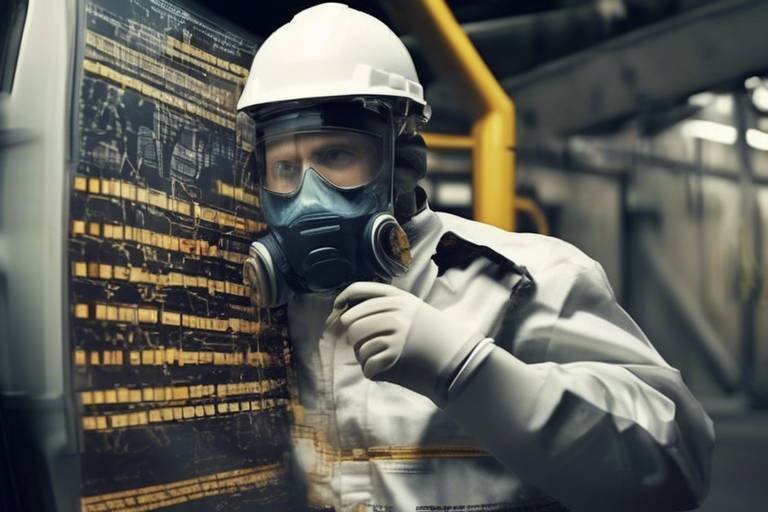What does Human Behavior teach about Safety Regulations?
In today's fast-paced world, where safety regulations are often seen as mere checkboxes to tick off, understanding human behavior becomes essential. Have you ever wondered why some people strictly adhere to safety protocols while others seem to disregard them completely? This article dives deep into the intricate relationship between human behavior and safety regulations, revealing how psychological factors can significantly enhance compliance and, ultimately, improve safety across various environments.
At its core, human behavior is influenced by a myriad of factors, including emotions, perceptions, and social dynamics. When it comes to safety regulations, these factors play a pivotal role in determining whether individuals choose to follow guidelines. For instance, consider a construction site where workers are required to wear helmets. One worker might see it as a necessary precaution, while another might view it as an inconvenience. This divergence in perception can lead to varying levels of compliance, which can have serious implications for workplace safety.
Moreover, understanding the motivations behind adherence to safety protocols is crucial. People often comply with regulations due to a combination of personal beliefs, past experiences, and the influence of their peers. On the flip side, barriers such as complacency, lack of awareness, or even the perception that regulations are overly burdensome can hinder compliance. By identifying these psychological barriers, organizations can tailor their strategies to foster a culture of safety that resonates with their workforce.
In summary, the relationship between human behavior and safety regulations is complex and multifaceted. By delving into the psychological factors that drive compliance, we can develop more effective strategies that not only enhance safety but also promote a positive attitude towards regulations. The next sections will explore these themes in greater depth, focusing on risk perception, social norms, cognitive dissonance, and the vital role of training and education.
Understanding the psychological factors that influence compliance with safety regulations is crucial for developing effective strategies. This section will delve into the motivations behind adherence and the barriers to following safety protocols.
How do individuals perceive risk, and how does that affect their decision-making regarding safety? This question is at the heart of understanding human behavior in relation to safety regulations. Cognitive biases often cloud our judgment, leading us to underestimate risks or overestimate our ability to manage them. For example, someone might think, "I’ve been driving for years without an accident, so I don’t need to wear a seatbelt." This mindset can create a dangerous disconnect from reality.
Social norms significantly impact individual behavior regarding safety regulations. When safety is viewed as a collective responsibility, compliance tends to increase. For instance, if a group of friends regularly discusses the importance of safety gear while biking, new members are likely to adopt these practices. This section discusses how group dynamics and societal expectations shape compliance and the role of peer pressure in promoting safety.
Peer pressure can be a double-edged sword. On one hand, it can encourage individuals to adopt safe practices, while on the other, it can lead them to take unnecessary risks. For example, in a workplace setting, if the majority of employees neglect to wear protective equipment, new hires might feel compelled to follow suit, even if they understand the risks involved. Therefore, fostering a supportive environment for safety compliance is essential.
Establishing positive social norms is crucial in promoting safety. This can be achieved through strong leadership and effective communication. When leaders prioritize safety and openly discuss its importance, it sets a precedent for others to follow. Moreover, recognizing and rewarding safe behaviors can reinforce these positive norms, creating a culture where safety is valued and prioritized.
Cognitive dissonance occurs when there is a conflict between a person's beliefs and their actions. For instance, an individual might believe that safety is important but still engage in risky behavior. Addressing this dissonance is key to encouraging safer practices. By providing education and resources that align actions with beliefs, organizations can help individuals resolve this internal conflict, leading to improved compliance with safety regulations.
Effective training and education are vital for enhancing safety compliance. Providing employees with the knowledge and skills necessary to understand and follow safety regulations can significantly reduce accidents and injuries. This section discusses various training methods and their impact on changing behaviors and attitudes toward safety regulations.
Interactive training methods engage participants more effectively than traditional approaches. Hands-on activities and simulations not only improve understanding but also enhance retention of safety protocols. For example, rather than simply lecturing about fire safety, conducting fire drills allows employees to practice what they’ve learned, making the information more memorable and applicable.
Ongoing education is essential for maintaining safety awareness. Regular refresher courses help reinforce the importance of safety regulations and keep them top-of-mind for employees. By making continuous learning a priority, organizations can promote long-term compliance and create a safer working environment.
- Why is understanding human behavior important for safety regulations? Understanding human behavior helps organizations tailor their safety strategies to improve compliance and create a culture of safety.
- How can social norms influence safety compliance? Social norms shape individual behaviors; when safety is prioritized within a group, members are more likely to comply with safety regulations.
- What is cognitive dissonance, and how does it affect safety behavior? Cognitive dissonance occurs when a person's beliefs conflict with their actions, which can lead to unsafe behaviors. Addressing this dissonance is crucial for promoting safety.
- What role does training play in enhancing safety compliance? Effective training equips individuals with the knowledge and skills necessary to adhere to safety regulations, ultimately reducing accidents and injuries.

The Psychology of Compliance
Understanding the psychological factors that influence compliance with safety regulations is crucial for developing effective strategies. At its core, compliance isn't just about rules and regulations; it's deeply rooted in human behavior. Why do some individuals follow safety protocols diligently while others disregard them? The answer often lies in a complex interplay of motivations, beliefs, and external influences. For instance, individuals may comply with safety regulations due to a genuine concern for their own well-being or that of their colleagues. Alternatively, they might feel pressured by organizational culture or peer expectations.
One significant factor affecting compliance is the perception of risk. When individuals underestimate the dangers associated with certain behaviors, they are less likely to adhere to safety regulations. This is where cognitive biases come into play. For example, the optimism bias leads individuals to believe that they are less likely to experience negative outcomes compared to others. This distorted view can create a false sense of security, making them more prone to risky behaviors. In contrast, when individuals are educated about the real risks involved, they are more likely to comply with safety measures.
Moreover, barriers to compliance can emerge from various sources. These may include a lack of understanding about the importance of safety protocols, perceived inconvenience, or even skepticism about the efficacy of the regulations themselves. For example, if an employee believes that wearing protective gear is uncomfortable and doesn't see immediate benefits, they might choose to forgo it. Addressing these barriers is essential for fostering a culture of compliance.
To truly enhance compliance, organizations must tap into the motivations of their employees. This can be achieved through a combination of effective communication, education, and positive reinforcement. By creating an environment where safety is prioritized and valued, organizations can encourage individuals to internalize safety regulations as part of their daily routines. The key is to foster a mindset where safety is not seen as an obligation but as a shared responsibility.
In summary, the psychology of compliance is a multifaceted issue that requires a deep understanding of human behavior. By addressing the motivations and barriers that influence compliance, organizations can enhance safety practices and ultimately create a safer working environment for everyone.
- What are the main factors influencing compliance with safety regulations? Compliance is influenced by risk perception, cognitive biases, organizational culture, and individual motivations.
- How can organizations improve safety compliance? By providing education, clear communication, and positive reinforcement, organizations can foster a culture of safety.
- What role does peer pressure play in safety compliance? Peer pressure can either encourage or discourage safe practices, making it essential to create supportive environments.

Risk Perception and Decision Making
When it comes to safety, how we perceive risk plays a pivotal role in our decision-making processes. It's fascinating to think about how our brains interpret potential dangers and how those interpretations influence our actions. For instance, have you ever noticed how some people seem to thrive on taking risks, while others are more cautious? This disparity can often be traced back to individual differences in risk perception. Understanding these differences is not only crucial for personal safety but also for creating effective safety regulations that resonate with everyone.
One of the key elements that influence our risk perception is cognitive bias. This refers to the systematic patterns of deviation from norm or rationality in judgment. For example, the optimism bias leads many individuals to believe that they are less likely to experience negative events compared to others. This can result in a dangerous mindset where people underestimate the likelihood of accidents or injuries, thinking, “It won’t happen to me.” Such biases can cloud judgment and lead to poor decision-making when it comes to safety protocols.
Moreover, the way we process information about risks can be significantly affected by our emotions. Fear can be a double-edged sword; while it can motivate individuals to adhere to safety regulations, it can also lead to avoidance behaviors. For instance, someone might feel overwhelmed by the fear of an accident and choose to ignore safety training altogether. This emotional response can create a cycle of ignorance where the lack of knowledge further fuels unsafe practices.
To illustrate the complexity of risk perception, consider the following table that outlines common cognitive biases and their potential impact on safety behavior:
| Cognitive Bias | Description | Impact on Safety |
|---|---|---|
| Optimism Bias | Belief that one is less likely to experience negative events than others. | Underestimation of risk, leading to non-compliance with safety measures. |
| Availability Heuristic | Relying on immediate examples that come to mind when evaluating a specific topic. | Overemphasis on recent accidents may lead to heightened fear and avoidance. |
| Confirmation Bias | Favoring information that confirms existing beliefs while disregarding contrary evidence. | Resistance to adopting new safety practices or regulations. |
Understanding these biases is essential for organizations aiming to improve safety compliance. By educating employees about these cognitive traps, companies can foster a more informed workforce that makes safer choices. Furthermore, incorporating risk education into safety training can help individuals recognize and mitigate their biases. It’s like teaching someone to see through a foggy window; once they understand the distortions, they can make clearer, more informed decisions.
In addition to cognitive biases, the environment plays a significant role in shaping our risk perception. Social influences, such as peer behavior and organizational culture, can either reinforce or challenge individual risk perceptions. For instance, if a workplace culture downplays the importance of safety, employees may adopt a similar attitude, leading to a collective disregard for safety protocols. On the flip side, when safety is prioritized and openly discussed, it creates an atmosphere where individuals feel empowered to adhere to regulations.
Ultimately, enhancing risk perception is not just about changing individual attitudes; it’s about creating a holistic approach that includes education, open communication, and a supportive environment. When individuals feel safe to express concerns and seek clarification about safety protocols, it fosters a culture of compliance that benefits everyone. So, the next time you think about safety regulations, remember that understanding how we perceive risk is just as important as the regulations themselves. It’s a delicate dance between our minds and our environments, and getting it right can save lives.
- What is risk perception? Risk perception refers to the subjective judgment people make about the characteristics and severity of a risk.
- How do cognitive biases affect safety behavior? Cognitive biases can distort our understanding of risks and lead to poor decision-making regarding safety protocols.
- Why is social influence important in risk perception? Social influences can shape our attitudes towards safety, either reinforcing or undermining compliance with safety regulations.
- How can organizations improve risk perception among employees? Organizations can improve risk perception by providing education, fostering open communication, and creating a supportive safety culture.

Influence of Social Norms
Social norms are like the invisible strings that pull at our behaviors, shaping how we act in various situations. They are the unwritten rules of society, and when it comes to safety regulations, these norms can either be a friend or a foe. Imagine walking into a crowded room where everyone is wearing a helmet; you’d probably feel a bit out of place without one, right? This is the power of social norms— they create expectations that can significantly influence individual behavior.
In workplaces, for instance, if safety gear is commonplace and visibly used by peers, it sets a standard. Employees are more likely to adhere to safety protocols when they see their colleagues doing the same. Conversely, if they observe a lack of compliance, it can lead to a collective mindset that disregards safety measures. This phenomenon is often referred to as the “bystander effect,” where individuals assume that someone else will take responsibility for ensuring safety.
Furthermore, the role of leadership cannot be overstated. When leaders prioritize safety and model compliant behavior, it sends a strong message throughout the organization. Employees are more likely to follow suit when they see their managers donning safety gear and actively participating in safety drills. This creates a culture of accountability and encourages everyone to take safety seriously.
To illustrate this point, consider the following table that outlines how social norms can impact safety compliance in different environments:
| Environment | Positive Social Norms | Negative Social Norms |
|---|---|---|
| Workplace | Team members consistently use safety gear. | Some employees neglect to wear safety equipment. |
| Community | Neighborhood watch programs promote safety awareness. | Lack of concern for local safety issues. |
| Schools | Students participate in safety drills enthusiastically. | Students ignore fire alarm protocols. |
In addition to peer influence, societal expectations play a crucial role in shaping our behaviors. For instance, when safety regulations are seen as a shared value within a community, individuals are more likely to embrace and adhere to them. This can be particularly impactful in high-risk industries where the consequences of non-compliance can be dire. By fostering an environment where safety is celebrated and prioritized, organizations can create a positive feedback loop that reinforces safe behaviors.
Ultimately, understanding the influence of social norms is essential for developing effective safety strategies. By leveraging these norms, organizations can cultivate a culture that not only encourages compliance but also empowers individuals to take ownership of their safety and that of their peers. So, the next time you think about safety regulations, remember that it's not just about rules—it's about the people and the social fabric that binds them together.

Peer Pressure and Safety
Peer pressure is a powerful force that can shape our behaviors in profound ways, especially when it comes to safety practices. Imagine walking into a workplace where everyone is wearing their protective gear, and you’re the only one without it. The discomfort you feel isn’t just about the gear; it’s about the invisible pressure to conform. This social influence can motivate individuals to adopt safe practices or, conversely, lead them to engage in risky behaviors. It’s like standing on the edge of a diving board; the crowd's cheers can either push you to take the plunge or hold you back in fear.
When discussing safety, it’s essential to recognize that peer pressure can manifest in various forms. It can be overt, such as direct encouragement from colleagues, or subtle, like the unspoken expectation to follow the group’s lead. This dynamic is especially crucial in environments where safety regulations are paramount, such as construction sites, laboratories, or healthcare facilities. Here are some ways peer pressure influences safety:
- Positive Reinforcement: When team members support one another in adhering to safety protocols, it creates a culture of accountability. This environment encourages individuals to prioritize safety over shortcuts.
- Negative Consequences: Conversely, if an individual observes peers ignoring safety measures, they may feel pressured to do the same, believing that fitting in is more important than following regulations.
- Group Dynamics: The desire to be accepted can lead individuals to downplay risks, especially if they see others doing so. This can create a dangerous cycle where safety becomes secondary to social acceptance.
To combat the negative aspects of peer pressure, organizations must foster a supportive atmosphere that encourages safe behavior. This involves not only setting clear safety standards but also actively promoting them through leadership and communication. For instance, when leaders model safe practices and openly discuss the importance of safety, it sets a tone that resonates throughout the organization. It’s like planting seeds in a garden; with proper care and attention, those seeds will grow into a thriving culture of safety.
Moreover, training sessions can be designed to emphasize teamwork and collective responsibility. Engaging employees in discussions about peer pressure and its effects on safety can help them recognize these influences and make more informed choices. By addressing peer pressure head-on, we can cultivate an environment where safety is not just an individual responsibility but a shared commitment among all members of a team.

Creating Positive Social Norms
In any environment, whether it’s a workplace, school, or community, the establishment of positive social norms is crucial for fostering a culture of safety. Just like a well-tended garden flourishes, an environment where safety is prioritized can lead to healthier, more productive interactions among individuals. But how do we cultivate these norms? It all starts with leadership and effective communication.
Leaders play a pivotal role in shaping the safety culture. When leaders actively demonstrate commitment to safety, it sends a powerful message that safety is a priority. For instance, if a manager consistently wears protective gear and follows safety protocols, it encourages employees to do the same. This behavior can create a ripple effect, where others feel compelled to conform to these safety standards. It’s akin to a domino effect: one positive action leads to another, creating a chain reaction of compliance.
Moreover, communication is vital in establishing and reinforcing positive social norms. Clear, open lines of communication allow individuals to express concerns and share experiences related to safety. When people feel heard, they are more likely to engage in safe practices. Regular safety meetings, where everyone is encouraged to participate, can foster an environment of trust and collaboration. Consider using visual aids, such as
| Training Method | Benefits |
|---|---|
| Lecture-Based | Provides foundational knowledge; easy to implement. |
| Interactive Workshops | Enhances engagement; promotes teamwork and collaboration. |
| Simulations | Allows for practical application; builds confidence in real-life scenarios. |
| Refresher Courses | Reinforces knowledge; keeps safety top of mind. |
In conclusion, the role of training and education in promoting safety compliance cannot be overstated. By investing in comprehensive and engaging training programs, organizations can cultivate a culture of safety that not only protects employees but also enhances overall productivity. After all, when individuals feel safe and confident in their environment, they are more likely to thrive.
- Why is training important for safety compliance? Training provides individuals with the knowledge and skills necessary to recognize hazards and follow safety protocols effectively.
- What are some effective training methods? Interactive workshops, simulations, and refresher courses are all effective methods that engage participants and enhance learning.
- How often should refresher courses be held? Refresher courses should be scheduled regularly, ideally every six months to a year, to keep safety knowledge fresh.

Interactive Training Techniques
When it comes to safety training, engaging participants is key to ensuring that they not only understand the material but also retain it. Traditional training methods, such as lectures and PowerPoint presentations, often fail to capture attention and can lead to a superficial understanding of crucial safety protocols. offer a refreshing alternative that actively involves participants in the learning process. Imagine a classroom where individuals are not just passive listeners but active participants, experimenting with safety measures in real-time. This approach transforms the mundane into something memorable.
One of the most effective interactive techniques is the use of hands-on activities. These activities allow participants to practice safety procedures in a controlled environment, giving them a chance to experience the protocols firsthand. For example, in a construction safety training session, participants might engage in a simulated scenario where they must identify hazards on a job site. This kind of immersive experience not only reinforces the learning objectives but also boosts confidence in applying these skills in real-world situations.
Another powerful method is the incorporation of simulations. Simulations can replicate emergency situations, allowing trainees to respond as they would in real life. This not only enhances their decision-making skills but also helps them manage stress and anxiety during critical moments. For instance, a fire safety training simulation could involve participants navigating through a smoke-filled environment, practicing evacuation procedures in a safe yet realistic setting. The adrenaline rush of a simulated emergency can make a lasting impression, solidifying the importance of safety protocols in their minds.
Furthermore, group discussions and role-playing exercises can significantly enhance the learning experience. These techniques encourage participants to share their thoughts, ask questions, and learn from each other. In a role-playing scenario, individuals could take on different roles, such as a safety officer, a worker, or even a bystander, to explore various perspectives on safety compliance. This not only fosters a deeper understanding of safety regulations but also encourages empathy and teamwork, essential components in promoting a culture of safety.
To illustrate the benefits of these interactive training techniques, consider the following
| Training Technique | Benefits |
|---|---|
| Hands-on Activities | Enhances skill retention and builds confidence in applying safety measures. |
| Simulations | Prepares participants for real-life emergencies, improving decision-making under pressure. |
| Group Discussions | Encourages collaboration and deeper understanding through shared experiences. |
| Role-Playing | Fosters empathy and teamwork, crucial for a safety-conscious environment. |
In conclusion, the shift towards interactive training techniques is not just a trend; it’s a necessity for effective safety education. By making training sessions more engaging and participatory, organizations can significantly improve safety compliance among their employees. Remember, learning about safety doesn’t have to be a chore. When participants are involved and invested, they are more likely to internalize the information and apply it in their daily routines. So, the next time you’re designing a safety training program, think outside the box and incorporate these interactive methods. They just might save a life!
Q: What are interactive training techniques?
A: Interactive training techniques are methods that actively engage participants in the learning process, such as hands-on activities, simulations, group discussions, and role-playing exercises.
Q: Why are interactive training techniques more effective than traditional methods?
A: Interactive techniques promote better retention of information, encourage active participation, and help individuals practice skills in realistic scenarios, making the training more memorable and applicable.
Q: How can I implement interactive training techniques in my organization?
A: Start by assessing your training needs and then incorporate hands-on activities, simulations, and discussions into your curriculum. Consider involving employees in the design process to ensure the training is relevant and engaging.

Continuous Education and Refreshers
In today's fast-paced world, where change is the only constant, continuous education and refresher courses are not just beneficial; they are essential for maintaining a culture of safety. Imagine trying to navigate a busy highway without ever updating your driving skills or knowledge of traffic laws. It would be a recipe for disaster, right? The same principle applies to safety regulations in various environments—be it workplaces, schools, or public spaces. Continuous education ensures that individuals remain aware of the latest safety protocols, technologies, and best practices, which ultimately leads to a safer environment for everyone.
One of the key reasons why refresher courses are vital is that they help to combat the natural tendency to forget. Studies show that without regular reinforcement, people can lose up to 70% of what they learn within a week. This statistic highlights the importance of ongoing training, as it helps to keep safety knowledge fresh and top-of-mind. Moreover, refresher courses provide an opportunity to address any changes in regulations or procedures that may have occurred since the last training session.
Another significant advantage of continuous education is that it fosters a culture of safety awareness. When organizations commit to regular training, they send a clear message that safety is a priority. This commitment can motivate employees to take safety seriously, not just as a set of rules to follow, but as a shared responsibility among all team members. For instance, when employees participate in interactive training sessions, they engage in discussions, share experiences, and learn from one another. This collaborative approach enhances understanding and encourages a proactive attitude toward safety.
To illustrate the impact of continuous education, consider the following table showcasing the benefits of refresher courses:
| Benefits of Refresher Courses | Description |
|---|---|
| Knowledge Retention | Regular training helps individuals retain critical safety information, minimizing the risk of forgetfulness. |
| Adaptation to Change | Refresher courses keep employees updated on new regulations and safety practices. |
| Cultural Reinforcement | Ongoing education reinforces the importance of safety within the organizational culture. |
| Team Cohesion | Collaborative training fosters teamwork and shared responsibility for safety. |
In conclusion, continuous education and refresher courses play a crucial role in enhancing safety compliance. They not only help individuals retain important safety information but also create an environment where safety is valued and prioritized. Organizations that invest in ongoing training are not just checking a box; they are actively working to create a safer, more informed workforce. So, the next time you think about safety training, remember: it's not just a one-time event; it's a continuous journey toward a safer future.
- Why are refresher courses necessary?
Refresher courses are necessary to reinforce knowledge, keep employees updated on changes in safety regulations, and maintain a culture of safety awareness. - How often should refresher courses be conducted?
The frequency of refresher courses can vary, but they are generally recommended at least once a year or whenever there are significant changes in safety protocols. - What are the benefits of interactive training methods?
Interactive training methods engage participants more effectively, improve retention of safety protocols, and foster collaboration among team members.
Frequently Asked Questions
- What are the main psychological factors influencing compliance with safety regulations?
Compliance with safety regulations is heavily influenced by various psychological factors, including motivation, perceived risk, and cognitive biases. Understanding these factors helps organizations develop effective strategies to encourage adherence to safety protocols.
- How does risk perception affect decision-making regarding safety?
Risk perception plays a crucial role in how individuals make decisions about safety. Cognitive biases can distort the perception of risk, leading to unsafe behaviors. Education on risk can empower individuals to make informed decisions and prioritize safety.
- What role do social norms play in safety compliance?
Social norms significantly influence individual behavior related to safety regulations. Group dynamics and societal expectations can either promote or hinder compliance. Peer pressure can motivate individuals to adhere to safety practices when a supportive environment is fostered.
- How can organizations create positive social norms for safety?
Creating positive social norms involves effective leadership and clear communication. Organizations can promote a culture of safety by encouraging open discussions about safety practices, recognizing safe behaviors, and providing support among peers.
- What is cognitive dissonance, and how does it relate to safety behavior?
Cognitive dissonance occurs when there is a conflict between an individual's beliefs about safety and their actual behaviors. Addressing this dissonance through awareness and training can encourage individuals to align their actions with their safety beliefs, leading to safer practices.
- Why is training important for enhancing safety compliance?
Training is vital for enhancing safety compliance as it equips individuals with the necessary knowledge and skills to adhere to safety regulations. Effective training methods, especially interactive ones, can significantly improve understanding and retention of safety protocols.
- What are some effective training techniques for safety education?
Interactive training techniques, such as hands-on activities and simulations, engage participants more effectively than traditional lectures. These methods enhance understanding and retention of safety protocols, making them more likely to be followed in real-life situations.
- How often should safety training be refreshed?
Ongoing education and refresher courses are essential for maintaining safety awareness. Regular training helps reinforce knowledge and adapt to any changes in safety regulations, ensuring long-term compliance and a strong safety culture.





















